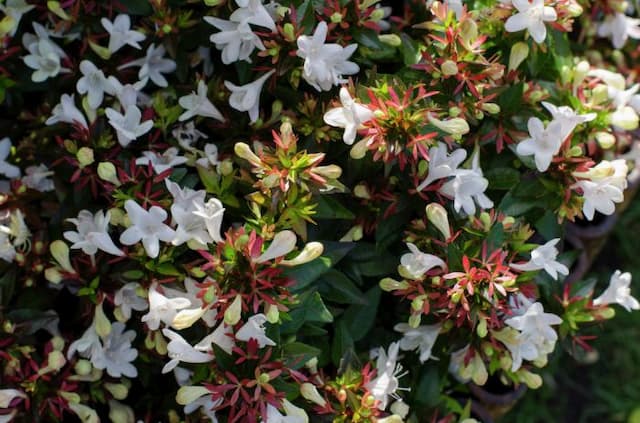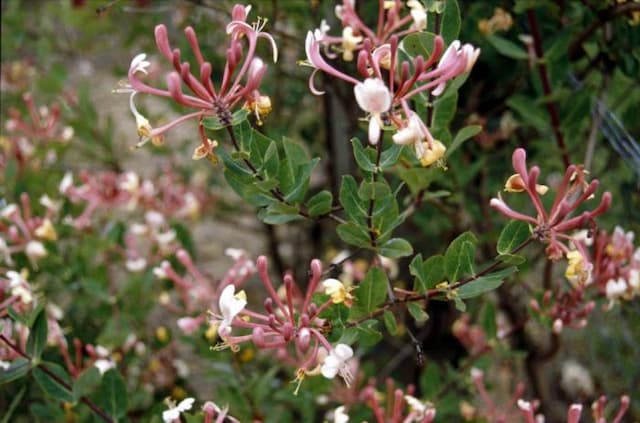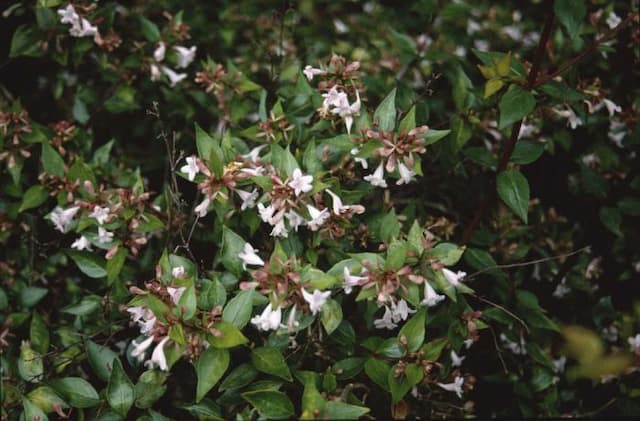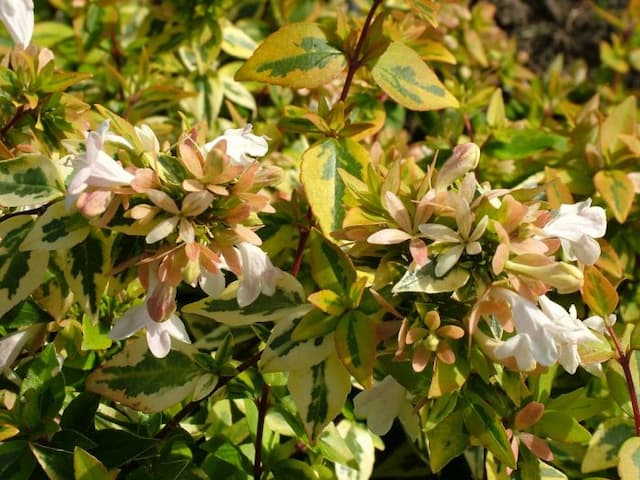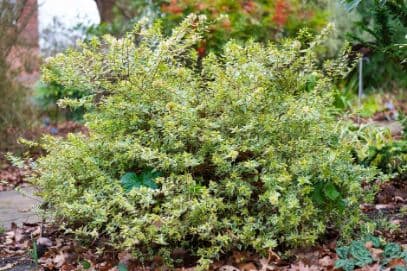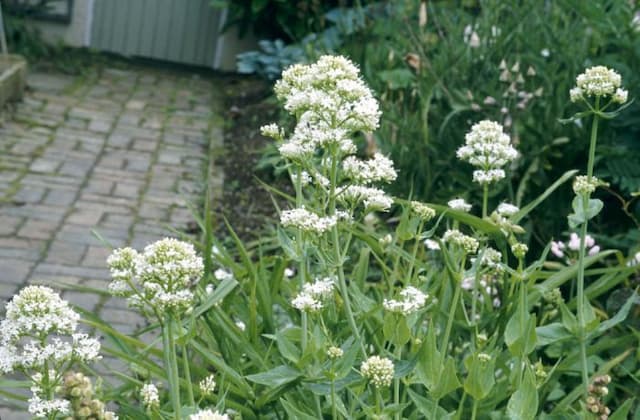Glossy Abelia Abelia × grandiflora 'Hopleys' (PBR) (v)

ABOUT
Abelia 'Hopleys' is a striking garden shrub with a dense and bushy habit. The plant is known for its decorative foliage and beautiful flowers. Its leaves are variegated and exhibit a mix of green and creamy-yellow to soft yellow hues, which can sometimes develop pink tints in the cooler months, adding year-round visual interest to any garden. The flowers of Abelia 'Hopleys' are equally attractive, with an abundance of small, trumpet-shaped blossoms that dangle elegantly from the branches. These delicate flowers are typically a soft lilac-pink in color, arranged in clusters, and tend to bloom profusely from late spring throughout the summer, sometimes even until the first frosts of autumn. They offer a delightful contrast against the variegated leaves and can attract pollinators like bees and butterflies to the garden. In addition to its leaves and flowers, Abelia 'Hopleys' also features reddish stems that can add further interest and a touch of warmth to the overall appearance. The plant's natural form makes it an excellent choice for adding structure and color to borders or as part of a mixed garden arrangement, and it's equally effective when planted as a stand-alone specimen. Despite the exclusion of its dimensions, it's worth noting that its size makes it adaptable to a range of garden spaces without dominating the area.
About this plant
 Names
NamesSynonyms
Glossy Abelia, Hopleys Variegated Abelia.
Common names
Abelia × grandiflora 'Hopleys' (PBR) (v)
 Toxicity
ToxicityTo humans
Abelia 'Hopleys' is generally considered non-toxic to humans. There are no well-documented adverse effects from ingesting this plant. However, as with any plant material, individual allergies or sensitivities could occur, and it is always advisable to refrain from eating ornamental plants.
To pets
Abelia 'Hopleys' is also generally regarded as non-toxic to pets. It is not known to cause any significant symptoms of poisoning if pets were to ingest parts of the plant. Still, pet owners should monitor their animals and prevent them from eating large quantities of any non-food plants due to the potential for stomach upset or an unexpected allergic reaction.
 Characteristics
CharacteristicsLife cycle
Perennials
Foliage type
Semi-deciduous
Color of leaves
Variegated
Flower color
Mixed
Height
3-5 feet (0.9-1.5 meters)
Spread
3-5 feet (0.9-1.5 meters)
Plant type
Shrub
Hardiness zones
6
Native area
China Korea
Benefits
 General Benefits
General Benefits- Attracts Pollinators: It produces flowers that draw bees and butterflies, supporting biodiversity.
- Year-round Interest: Semi-evergreen foliage and seasonal blooms provide visual appeal throughout the year.
- Drought Tolerance: Once established, it has a moderate level of drought resistance.
- Low Maintenance: Requires minimal pruning and care, making it a good choice for low-maintenance landscapes.
- Versatility: Suitable for a variety of garden uses including borders, foundation plantings, and hedges.
- Compact Size: Its moderate growth size makes it suitable for small gardens or spaces.
- Colorful Foliage: Features variegated leaves that add color and texture to the garden.
 Medical Properties
Medical PropertiesThis plant is not used for medical purposes.
 Air-purifying Qualities
Air-purifying QualitiesThis plant is not specifically known for air purifying qualities.
 Other Uses
Other Uses- Privacy Screening: Abelia can be planted in a row to create a semi-evergreen hedge for privacy purposes, as its foliage is dense and can obscure the view into a property.
- Nature Photography: The plant's attractive flowers and lush foliage make it a charming subject for nature photography enthusiasts looking to capture the beauty of a garden.
- Educational Tool: Abelia is a great plant for teaching botany and gardening due to its interesting hybrid nature and growing requirements.
- Lunar Gardening: This plant can be utilized in lunar gardening, where gardeners plant by the phases of the moon, as it can be planted during the waxing phase to encourage growth.
- Art Inspiration: Artists can use the intricate structure of Abelia’s flowers as inspiration for botanical illustrations and designs in various art forms.
- Garden Themed Parties: Abelias can be incorporated into the decor for garden themed parties, providing a serene and elegant atmosphere.
- Floral Circus: Gardeners can train Abelia's flexible branches into unusual shapes or forms for artistic garden displays akin to topiary but with a more natural, less strict form.
- Outdoor Crafting: The plant's stems and flowers can be used in crafting wreaths or other outdoor decorative items, where fresh or dried plant materials are desirable.
- Erosion Control: Abelia can be planted on slopes or in areas susceptible to erosion due to its root system that helps in holding the soil together.
- Sound Barrier: When planted in mass, Abelia's dense foliage can help to dampen traffic noise or neighborhood sounds, creating a quieter garden space.
Interesting Facts
 Feng Shui
Feng ShuiThe Glossy Abelia is not used in Feng Shui practice.
 Zodiac Sign Compitability
Zodiac Sign CompitabilityThe Glossy Abelia is not used in astrology practice.
 Plant Symbolism
Plant Symbolism- Abundance: The plentiful blooms of the glossy abelia represent abundance and generosity.
- Adaptability: It is a hybrid plant that can thrive in various conditions, symbolizing flexibility and resilience.
- Attraction: Its flowers are known to attract pollinators like bees and butterflies, making it a symbol of attraction and magnetism.
- Feminine Beauty: With its delicate pinkish-white flowers, the abelia is often associated with grace and the beauty of femininity.
- Perseverance: Able to bloom for a long time, the glossy abelia can signify perseverance and long-lasting effort.
 Water
WaterGlossy Abelia should be watered thoroughly once or twice a week, depending on weather conditions such as heat and drought. During the establishment period, which is the first growing season, make sure the plant receives about 1 gallon of water per session, ensuring that the soil remains consistently moist but not waterlogged. In subsequent years, water requirements may be reduced, and the plant can be watered when the top inch of soil feels dry to the touch. During prolonged dry spells or extreme heat, increase watering frequency to prevent stress. Overhead irrigation is not recommended; instead, use a soaker hose or drip system aimed at the root zone to effectively hydrate the plant.
 Light
LightGlossy Abelia thrives best in full sun to partial shade. Full sun leads to the best flowering and will also contribute to the foliage maintaining a rich color throughout the growing season. Ideally, plant Glossy Abelia in a spot that receives at least 6 hours of direct sunlight per day, although it can tolerate some light shade, especially in regions with very hot summers.
 Temperature
TemperatureGlossy Abelia is generally hardy in a range of temperatures, withstanding minimum winter temperatures down to about 5°F. It thrives in the ideal temperature range between 60°F and 85°F. Extended exposure to temperatures below the minimum can damage or kill the plant. Conversely, high summer temperatures are typically well-tolerated, though extreme heat may require additional watering to keep the plant healthy.
 Pruning
PruningPruning Glossy Abelia helps maintain its shape, encourages new growth, and can enhance flowering. Prune in late winter or early spring before new growth begins. Remove any dead, damaged, or crossing branches to improve air circulation. Cut back up to one third of the oldest stems to ground level annually to rejuvenate the plant. The best time for pruning is typically after the last frost of the season but before the onset of the spring growth spurt.
 Cleaning
CleaningAs needed
 Soil
SoilGlossy Abelia prefers well-draining soil with a high content of organic matter. The ideal soil mix can be created by combining two parts garden soil, one part peat or coir, and one part perlite or sand to ensure proper drainage. This shrub thrives in a soil pH range of 5.5 to 7.5, appreciating a slightly acidic to neutral soil environment.
 Repotting
RepottingGlossy Abelia, being a relatively slow-grower, does not require frequent repotting. It is typically repotted once it outgrows its current pot, or every 2 to 3 years. When repotting, it's important to only go up one pot size to avoid overwhelming the plant with too much soil, which can retain excess moisture leading to root issues.
 Humidity & Misting
Humidity & MistingGlossy Abelia is adaptable to a wide range of humidity levels but prefers a moderate humidity environment. It thrives outdoors where it can receive natural humidity but doesn't require any special humidity adjustments when planted in the ground. If grown indoors or in arid regions, it can benefit from occasional misting.
 Suitable locations
Suitable locationsIndoor
Position in bright, indirect light; ensure good air flow.
Outdoor
Plant in well-draining soil; full sun to partial shade.
Hardiness zone
6-9 USDA
 Life cycle
Life cycleThe Glossy Abelia 'Hopleys' variety begins its life as a seed, which germinates in favorable conditions of moisture and temperature, typically in the spring. After germination, the seedling emerges, growing into a young plant through vegetative growth, developing roots, stems, and leaves. As the plant matures, it enters the flowering stage, usually in the summer to fall, where it produces fragrant, tubular flowers that attract pollinators such as bees and butterflies. Following pollination, the flowers develop into seed capsules, which, when mature, release seeds, thus completing the reproductive cycle. Between flowering seasons, the Glossy Abelia 'Hopleys' maintains itself through vegetative growth, with pruning necessary to shape the plant and encourage new growth. The plant has a perennial life cycle and will go through the stages of growth, flowering, and seed production yearly, with semi-evergreen to evergreen foliage persisting through winter in milder climates.
 Propogation
PropogationPropogation time
Spring-Early Summer
The most popular method for propagating Abelia × grandiflora 'Hopleys', commonly known as Glossy Abelia, is through semi-hardwood cuttings. This type of propagation typically takes place in late summer when new growth has begun to mature and harden slightly. A cutting should be taken from the current year's growth, measuring about 4 to 6 inches (10 to 15 centimeters) in length. The lower leaves are removed to expose a clean section of stem, which is then dipped in rooting hormone to encourage root development. The prepared cutting is then placed in a well-drained potting mix and kept moist. A plastic cover or a propagator can be used to maintain humidity around the cutting. With proper care, roots will develop in a few weeks, and the new Glossy Abelia plant can eventually be transplanted outdoors.

